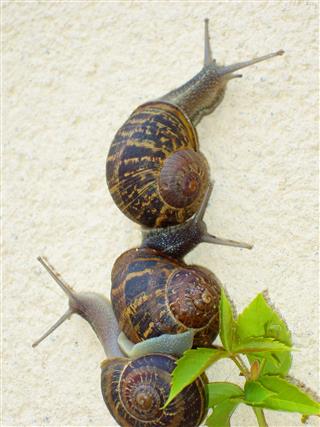
Mystery snails love to eat blanched green vegetables such as spinach, lettuce, and kale. Some of the species such as the Golden mystery snail also like to eat fish food such as shrimp pellets. As far as the aquarium settings are concerned, they are comfortable in alkaline water.
Did You Know?
Never feed starchy foods such as pasta, rice, and millet to your pet snail, as it can cause bloating and the snail may die soon after that.
Belonging to the Vivipariidae family of mollusks, mystery snails can make the environment of your aquarium more colorful since the snails of the South American variety come in many colors including blue, golden, and black. Mystery snails of the Chinese and Japanese origin, also known as trapdoor snails (it does not have a lung) are usually black in color and moss-like dark green algae are seen covering their shell.
How to Take Care of Mystery Snails
Water Conditions
- Under any circumstances, the water should not be acidic as it can damage the mystery snail’s shell. Studies have shown that acidic ocean waters tend to chip away the shells. There have been reports of shells getting considerably dissolved due to acidification. So make sure that you keep the mystery snails in strongly alkaline water, meaning the pH value of the tank water should be between 7.5 and 8.
- Mystery snails are the most comfortable when the water temperature lies between 65 degrees F and 82 degrees F. This range is essentially considered as room temperature, hence you may not require an aquarium heater for adjusting the temperature. However, in case the water is cooler or warmer than the recommended range, a heater is necessary to maintain tank water at the desired temperature.
- Also, mystery snails do best, when kept in hard water, since soft water is found to be detrimental to the snail’s shell. Exterior cell damage is commonly noticed in mystery cells placed in soft water. Gaps begin to develop during the formation of shells. The water hardness should vary from 5 to 15 dKH.
- Make sure the tank is well-ventilated with a secure lid, since they can easily crawl up and come out of the tank. The tank lid should have a sufficient number of air holes for ventilation.
- You can keep your pet snails along with other fish in the aquarium. However, some species of fish such as the Puffers and Loaches are infamous for killing snails. So take an expert advice before keeping mystery snails and fish together.
Food
- If you are looking for a natural way to control algae growth in your aquarium, then you can trust these mystery snails. The mystery snail, particularly the Japanese variety (trapdoor snail), can be a great addition to keep your tank’s algae under control. They also like to eat dead plant matter. As a supplemental feed nutrition, you can give them algae wafers that are an excellent source of vitamins.
- Since calcium helps promote a healthy shell growth, make sure to include fresh dark leafy greens such as spinach, turnips, kale, and collard greens in your snail’s diet. You can also supplement its diet with other vegetables like carrots, cucumbers, and green beans. Mystery snails usually prefer to eat blanched vegetables.
- The South American mystery snails such as the Pomacea bridgesii (Golden mystery snail) and Pomacea canaliculata will not nibble on natural plants, provided they are given the required food in adequate amounts on a daily basis. The Chinese mystery snails have been the preferred choice in aquariums as they neither consume plants nor harm the fish eggs.
- Mystery snails also like to eat fish food such as shrimp pellets. So, occasionally feed them a teaspoon or two of ground shrimp, which is also a good source of vitamins and minerals. Members of the Ampullariidae family also love to eat fish eggs.
Lifespan
- In captivity, the South American variety of this species has a short lifespan of 1.5-2 years. Whereas the Chinese mystery snails live for an average of 4 years.
Reproduction
- Unlike other species of snails such as the hermaphrodite that reproduce asexually, in case of mystery snails, a male and a female is necessary for breeding.
- Place snails of both sexes in the tank. Once they get familiar, you will soon notice eggs on the surface of the water. You need to slightly reduce the water level of the tank in order to view those eggs, which is essentially a pink egg mass that contains over 100 eggs. Within 2 to 3 weeks, the eggs start developing cracks, which pave way for tiny snails to come out.
- The Chinese mystery snail, member of the Viviparidae species of snails, does not lay eggs but gives birth directly to young ones.
Caution
- Copper is lethal to snails in general, since they are found to be very sensitive to this element. Copper levels as low as 0.01% in water are considered to be toxic to snails. So ensure that the water supply to the aquarium is free of copper.











